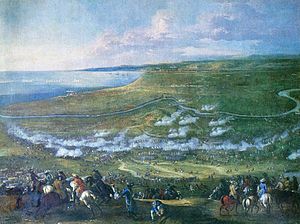Battle of Halmstad
| Battle of Halmstad | |||||||
|---|---|---|---|---|---|---|---|
| Part of the Scanian War | |||||||
 Battle of Halmstad |
|||||||
|
|||||||
| Belligerents | |||||||
|
|
|
||||||
| Commanders and leaders | |||||||
|
Charles XI Field Marshal Simon Grundel-Helmfelt |
Major General Jakob Duncan | ||||||
| Strength | |||||||
| 6,000 men | 3,500–4,000 men | ||||||
| Casualties and losses | |||||||
|
200: 144 wounded |
3,000: 2,000 captured |
||||||
200:
3,000:
The Battle of Halmstad (also known as the Battle at Fyllebro) was fought on August 17, 1676, at Fyllebro, approximately five kilometers south of the town Halmstad in southwest Sweden. It was the last battle in Halland between Denmark and Sweden.
The Danish army that landed at Helsingborg in Scania in late June 1676 managed to conquer almost the whole province in less than a month. The Swedish army had to retreat north to Växjö.
In early August, General Jakob Duncan with about 4,000 Danish troops was sent north, to the province of Halland, to take Halmstad and if possible advance further north to join General Ulrik Frederick Gyldenløve, who had reached Gothenburg with a Norwegian army and was threatening to besiege the city.
On August 11, King Charles XI and his small army headed west to intercept Duncan. General Duncan had been informed about Swedish troops heading in his direction but as he assumed that it was just a smaller unit under General Ascheberg, he made no haste when he decided to leave Halmstad and return south to Scania. At noon of August 17, the Swedish army reached the only road from Scania to Halmstad and Duncan was trapped. The Swedes destroyed the bridge leading south and headed north.
After just a few kilometres the Swedish vanguard under command of Ascheberg encountered a small Danish unit that was routed back north. After a short chase Ascheberg found himself face-to-face with Duncan and his forces. The Danish army was about to cross the bridge over the creek Fylleån. Duncan, who thought that the approaching enemy troops were the entire Swedish force, continued to let his men cross the bridge. Unaware of the danger he let his troops assume battle formations on the south bank with their backs against the creek.
Meanwhile, the Swedes brought forward the rest of their cavalry and infantry, which had been lagging behind. The battle started with a salvo from the few Swedish cannons, whereupon Charles XI and his Household cavalry charged down the hills to attack the Danish left wing. Soon the Swedes also charged on the left wing and in the center. After 15 minutes the Danish left wing was scattered. In the center the Danish infantry put up a determined fight, with a powerful counter-attack from a cavalry unit that tried to break through the Swedish lines, but only one squadron made it through.
...
Wikipedia
